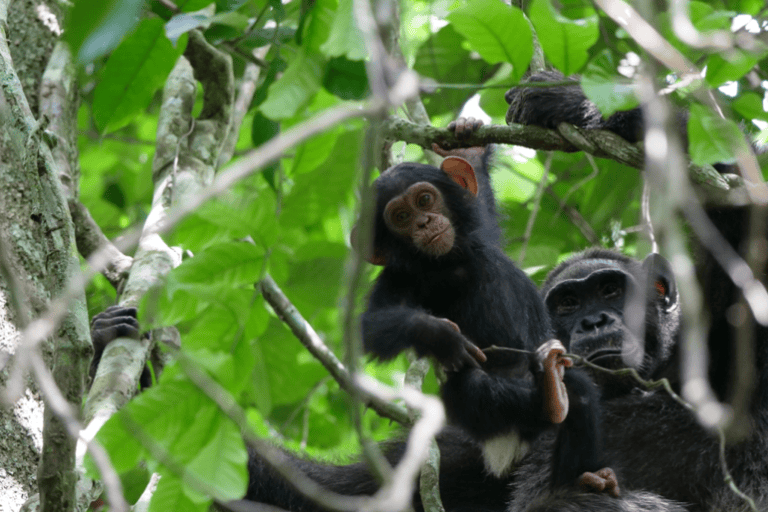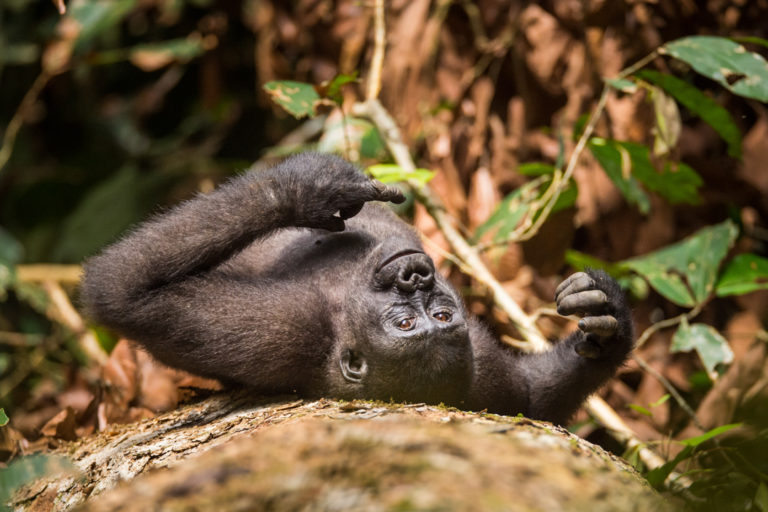- A new long-term study points to lasting social relationships between chimpanzees and gorillas in the wild.
- The study showed that individuals from both species actively seek out each other in a variety of contexts.
- The benefits of these interactions go beyond protection from predators, and include learning social skills and finding fruiting trees.
- But these social interactions also provide the potential for transmission of deadly diseases like Ebola, which pose as big a threat to the long-term survival of gorillas and chimps as hunting and habitat destruction.
Gorillas and chimpanzees living in a remote part of the Congo Basin hang out together and some, like humans, even establish “relationships with benefits,” a new study reveals.
Observations of eastern chimpanzees (Pan troglodytes schweinfurthii) and western lowland gorillas (Gorilla gorilla gorilla) in the Republic of Congo’s Nouabalé-Ndoki National Park carried out between 1999 and 2020 reveals that some of these benefits include something akin to friendship.
“On several occasions at food sources, we observed young gorillas and chimpanzees seeking out particular partners to engage in bouts of play which may afford unique developmental opportunities to extend their social, physical, and cognitive competencies,” says the study published in the journal iScience.
In one striking example, the team observed young chimpanzees beating their chests — a behavior that only gorillas have previously been recorded doing.
“While these chimpanzees could have spontaneously innovated chest-beating, they also regularly have the opportunity to observe gorillas exhibiting this behavior,” David Morgan, a research fellow at Chicago’s Lincoln Park Zoo and co-author of the study, told Mongabay.
“It is possible that the chimpanzees learned this gesture from the gorillas and that these species could share some cultural behaviors.”

The research was carried out in a remote study area in the park known as the Goualougo Triangle, which has overlapping populations of gorillas and chimpanzees that are habituated to human presence. The data gathered on these groups over more than 20 years gave the researchers a unique opportunity to understand how and why individual apes made their social choices.
The two species did sometimes clash violently, but that was not the norm and the clashes were never fatal, the study found. “The interspecies relationships we observed were overwhelmingly tolerant, frequently affiliative, and consistent over many years,” said study co-author Jake Funkhouser, a doctoral candidate in biological anthropology at Washington University in St. Louis. On whether this could equate to friendship, he said: “When considering the enduring bond between individual gorillas and chimpanzees, then yes, we can think of these relationships as friendships.”
Younger male gorillas, including subadults and so-called blackbacks, were found to share the strongest bonds with chimpanzees. Although the dominant and older silverbacks may not spend as much time interacting with chimpanzees, “the foundation of interspecies tolerance they established as youngsters is likely enduring,” Funkhouser said.
One benefit the gorillas obtained from these interactions was the opportunity to find food. This appears to contradict the traditional hypothesis that two different species occupying similar ecological niches will compete with and exclude each other from their communities.

Both the gorillas and chimpanzees are fond of figs, but fig trees are scarce in the Goualougo Triangle and their fruiting period only lasts a few days.
On a number of occasions while following groups of gorillas through the forest, the research team watched the animals change course and head toward chimpanzee calls in the canopies of fruiting figs. Other trees, like the evergreen Chrysophyllum lacourtianum and Pancovia laurentii, remain in fruit for weeks and provide the opportunity for prolonged interactions.
“On some occasions, part of the gorilla group would climb into the tree crown to feed with chimpanzees while others remained on the ground and fed upon fallen fruit,” the authors note.
There is security in numbers, and the researchers found that members of both species were closely attuned to each other’s alarm calls. Leopards (Panthera pardus) are known to prey on both chimpanzees and gorillas, and both ape species are wary of snakes and birds of prey like crowned eagles (Stephanoaetus coronatus).

Yntze van der Hoek, senior biodiversity researcher with the Dian Fossey Gorilla Fund, who was not part of the study, described the researchers’ findings as “fascinating” and “thought-provoking.”
But he said that while “tolerant” or even “affiliative” relationships between chimpanzees and gorillas can occur under specific conditions and for specific populations, a number of factors may create a plausible scenario for the interspecies interactions witnessed in the Goualougo Triangle.
Chimpanzees and gorillas are both highly social, share the same habitat across much of their range, and have an interest in the same food sources. Aggression may simply be too costly, and so tolerance would become the norm or even develop into “affiliation with benefits,” he said.
“I am not ruling out the possibility that this plays into factors such as the development of ‘enhanced social skills,’ but it seems also plausible that there is simply a certain level of tolerance that builds up from experience,” he said.
“But,” he added, “even just knowing that this level of ‘tolerance’ can exist is already an eye-opener.”

Living in close proximity has advantages, but also comes with risks. The study found there is ample opportunity for germs to spread. For instance, gorillas were seen feeding on scraps of fruit dropped by chimpanzees, or foraging on fruit in the leaf litter under trees where chimpanzees had foraged, urinated and defecated.
Diseases like Ebola and COVID-19, to which gorillas and chimpanzees are susceptible, present as great a threat to their survival as habitat loss and illegal hunting. For instance, a 2002-2003 outbreak of Ebola in the Democratic Republic of Congo killed around 5,000 western lowland gorillas. To mitigate against similar epidemics breaking out in Nouabalé-Ndoki National Park, rigorous health and safety protocols to protect and monitor ape health have been developed, the study’s lead author Crickette Sanz told Mongabay.
“We were early adopters of a One Health approach to address the interconnectedness of human, animal and environmental health,” she said. “The entire world has come to realize that infectious disease is a major threat to both humans and wildlife.”

Citations:
Sanz, C. M., Strait, D., Eyana Ayina, C., Massamba, J. M., Ebombi, T. F., Ndassoba Kialiema, S., … Morgan, D. B. (2022). Interspecific interactions between sympatric apes. iScience, 25(10), 105059. doi:10.1016/j.isci.2022.105059
Bermejo, M., Rodríguez-Teijeiro, J. D., Illera, G., Barroso, A., Vilà, C., & Walsh, P. D. (2006). Ebola outbreak killed 5000 gorillas. Science, 314(5805), 1564-1564. doi:10.1126/science.1133105
FEEDBACK: Use this form to send a message to the author of this post. If you want to post a public comment, you can do that at the bottom of the page.